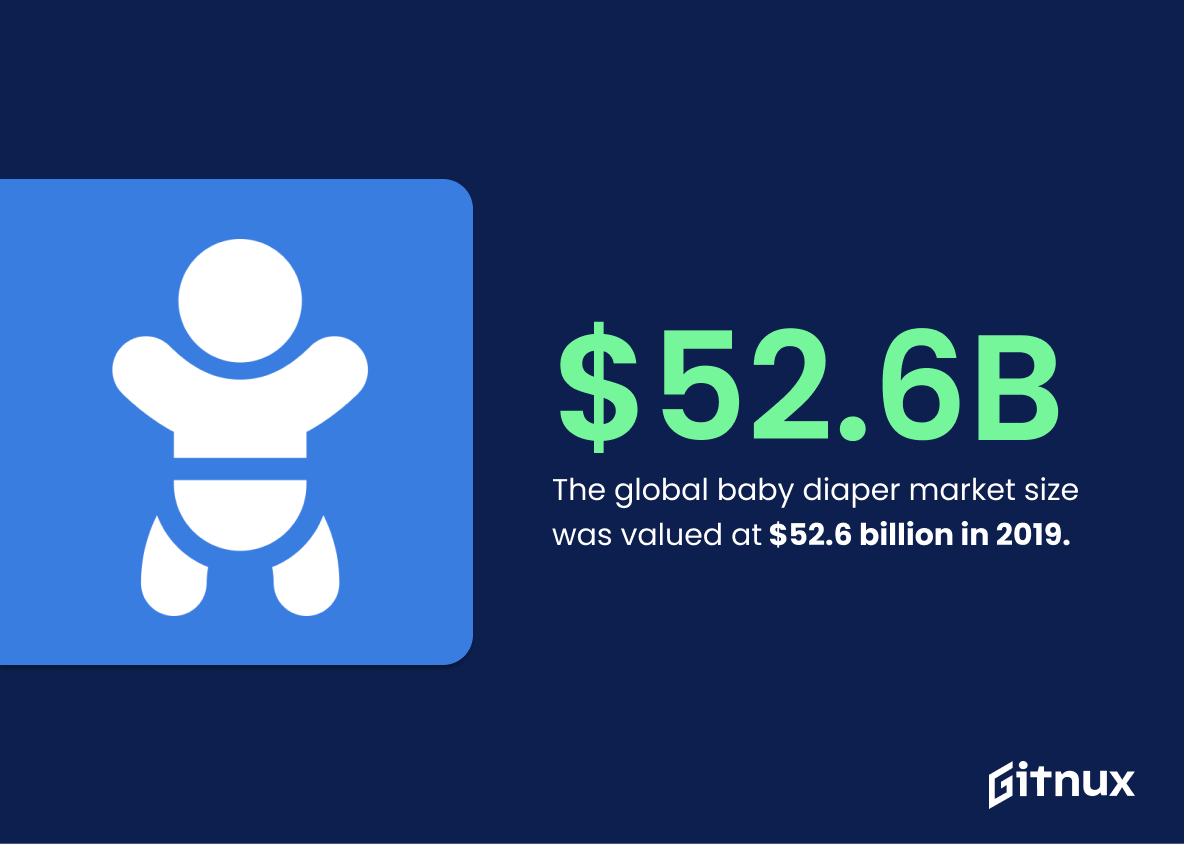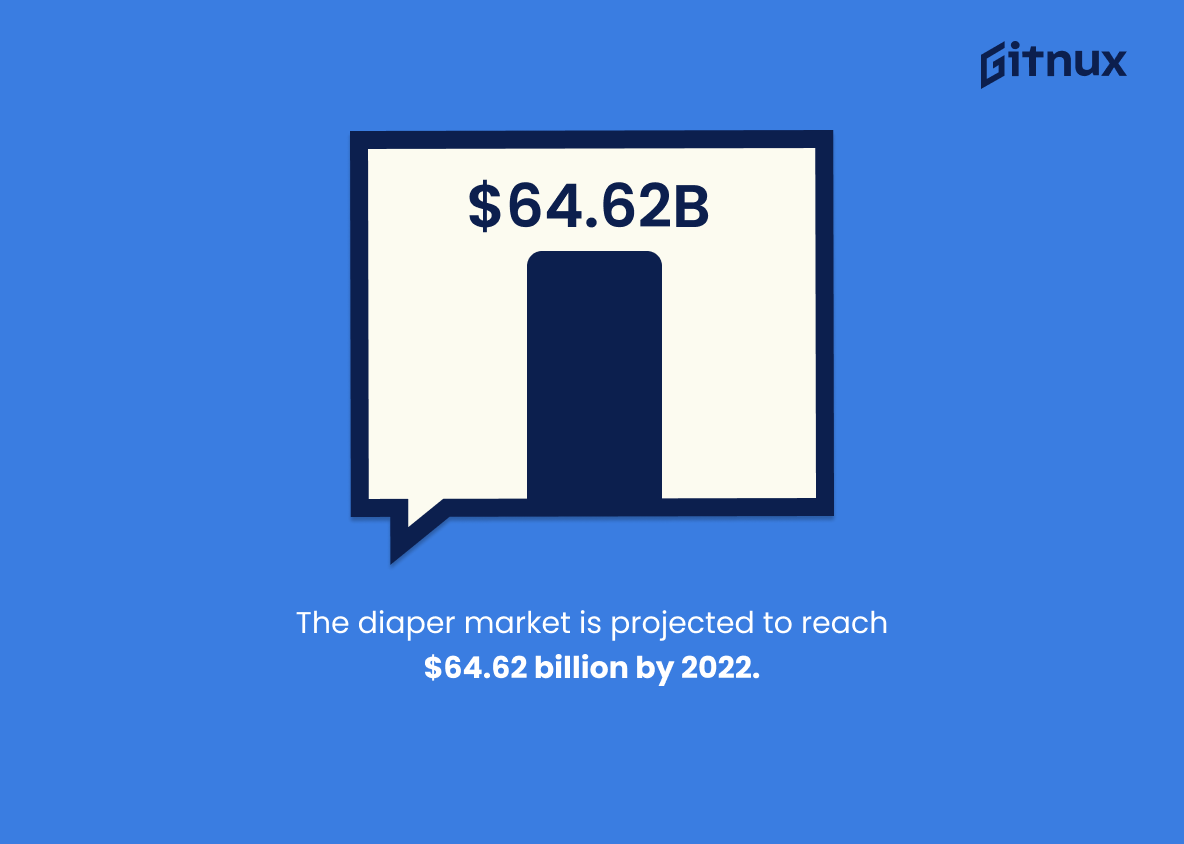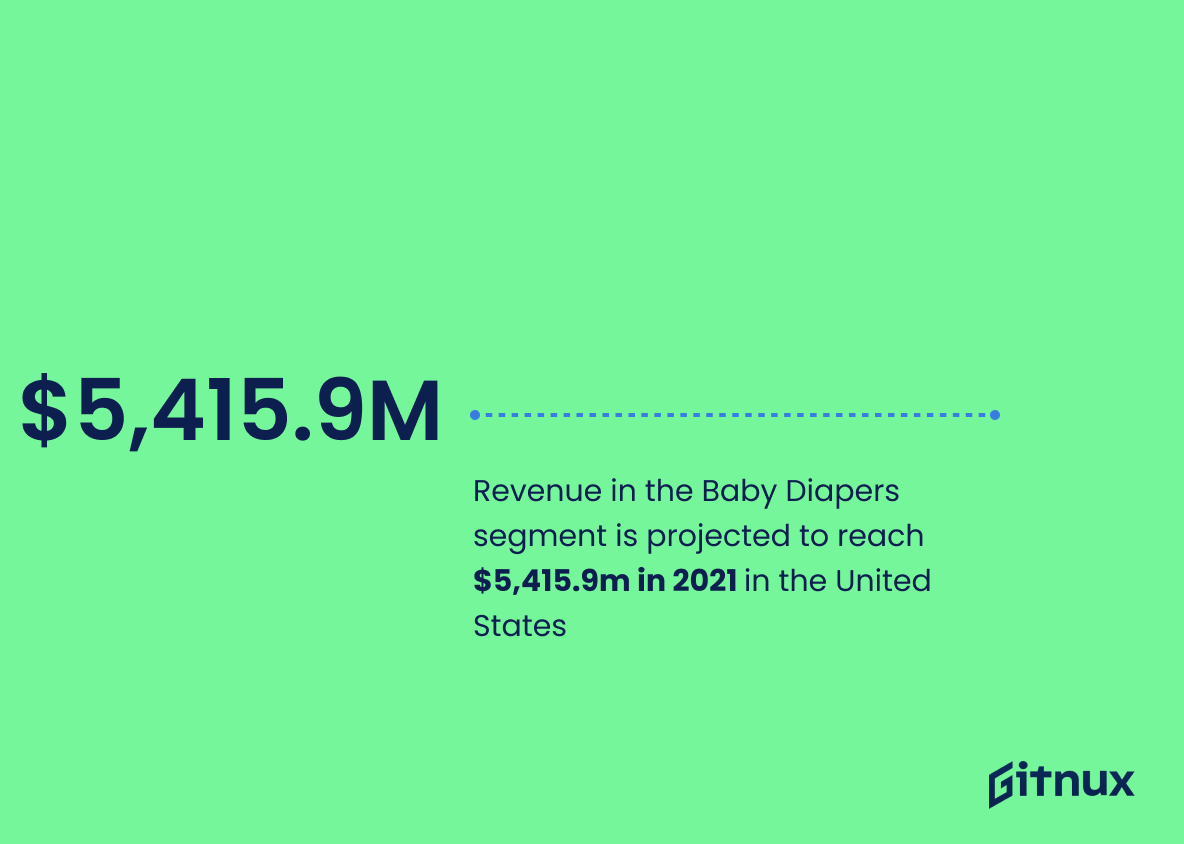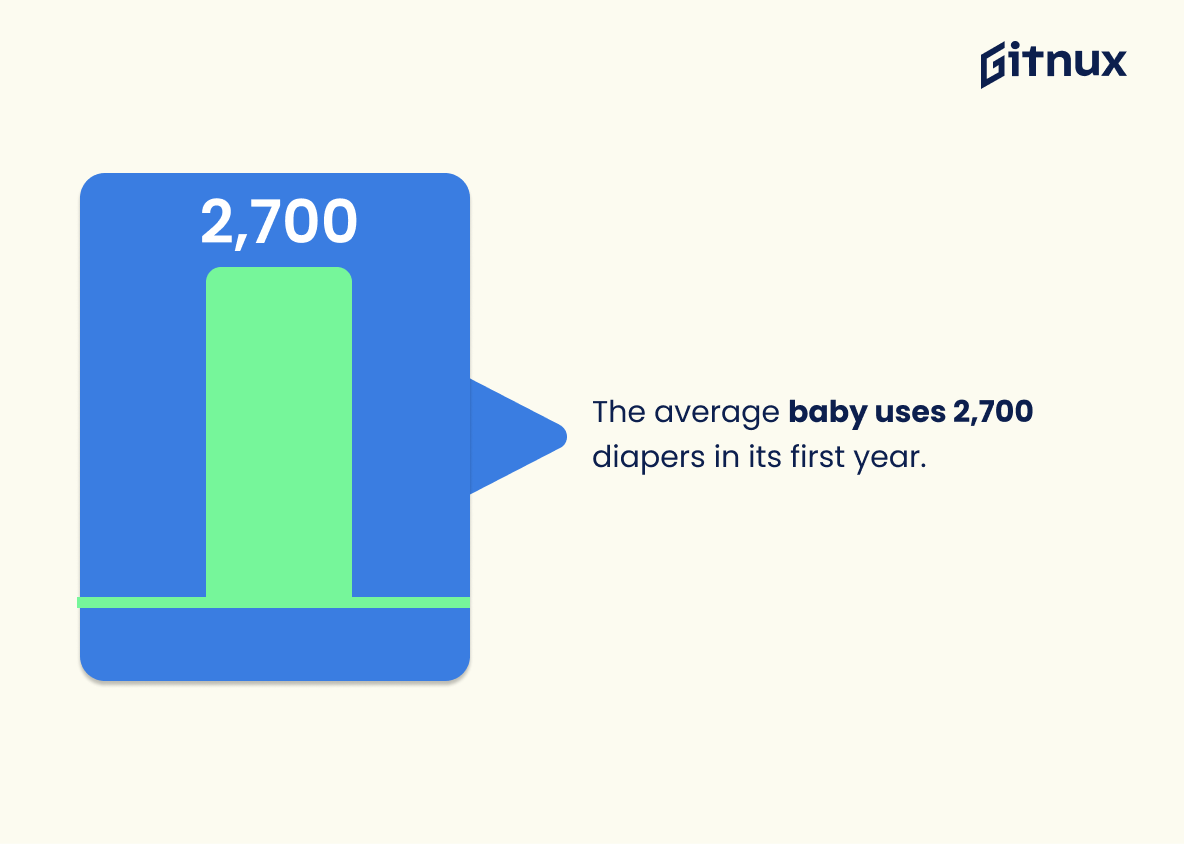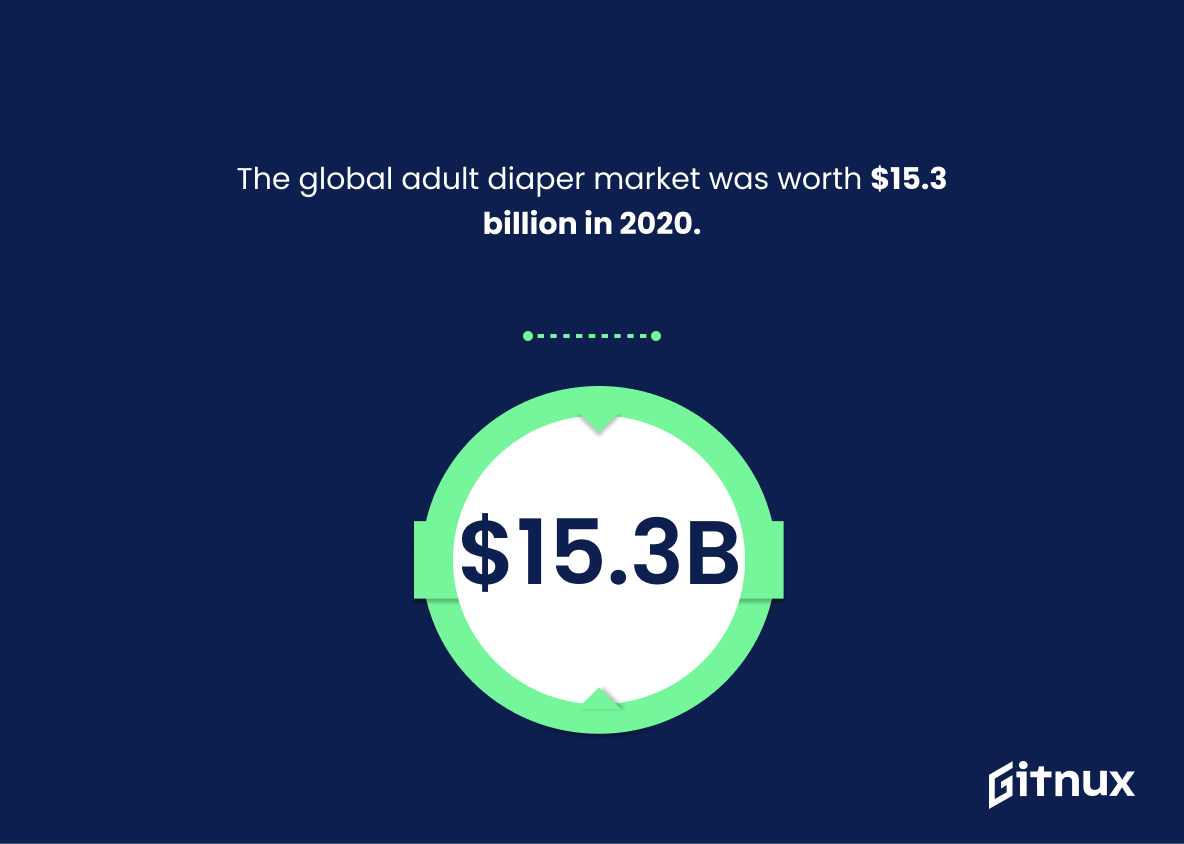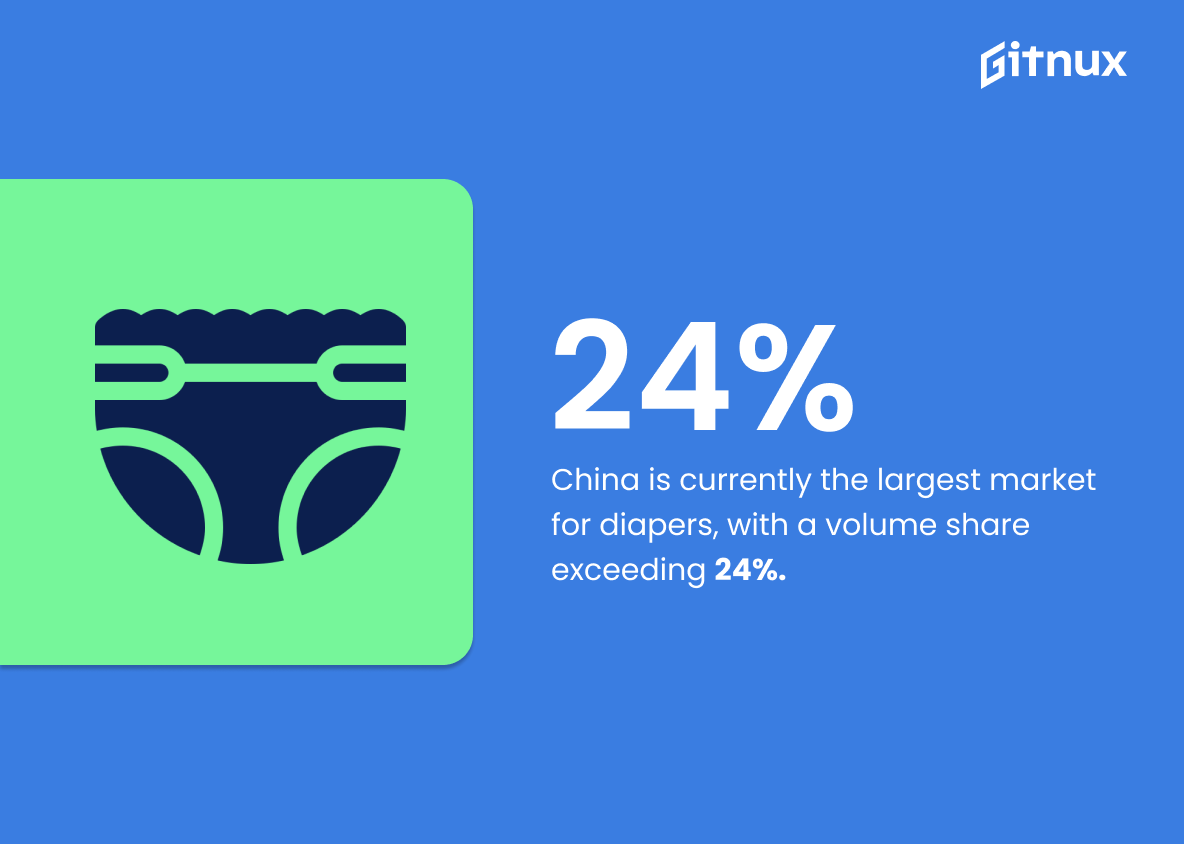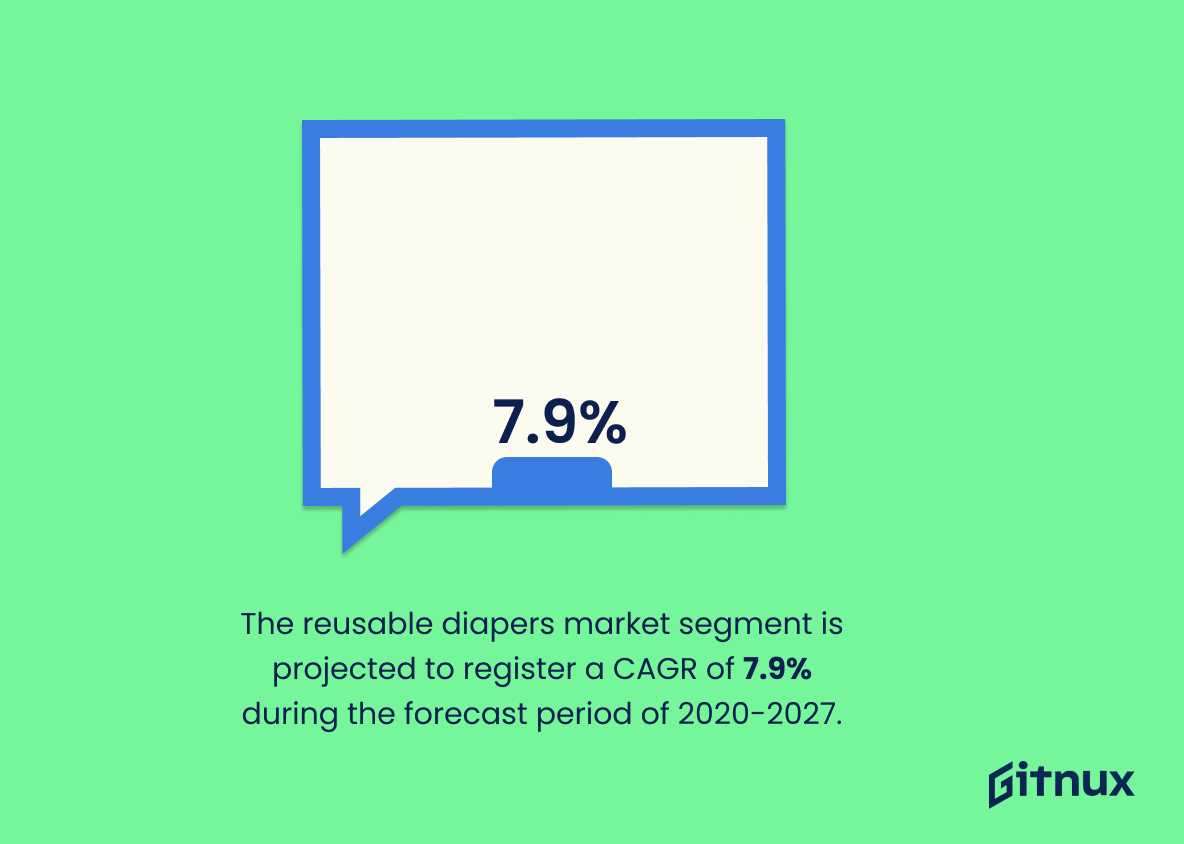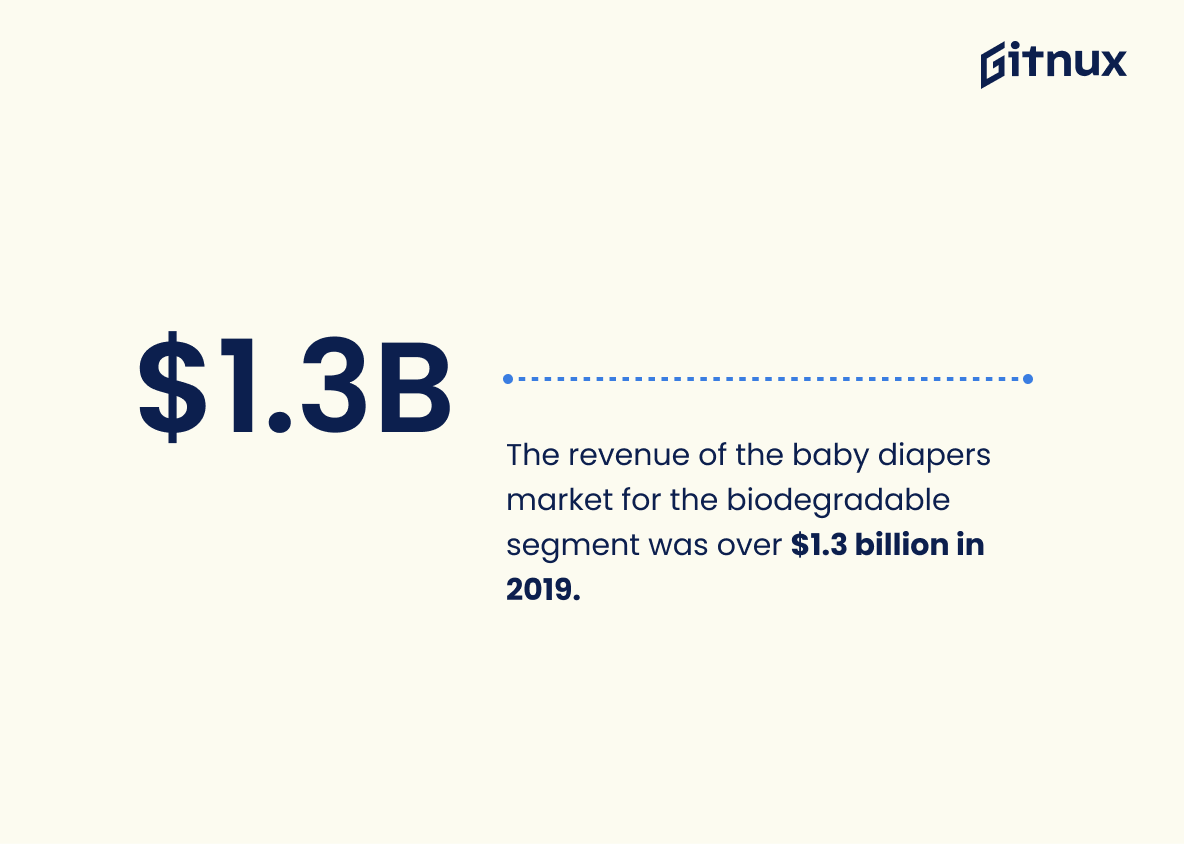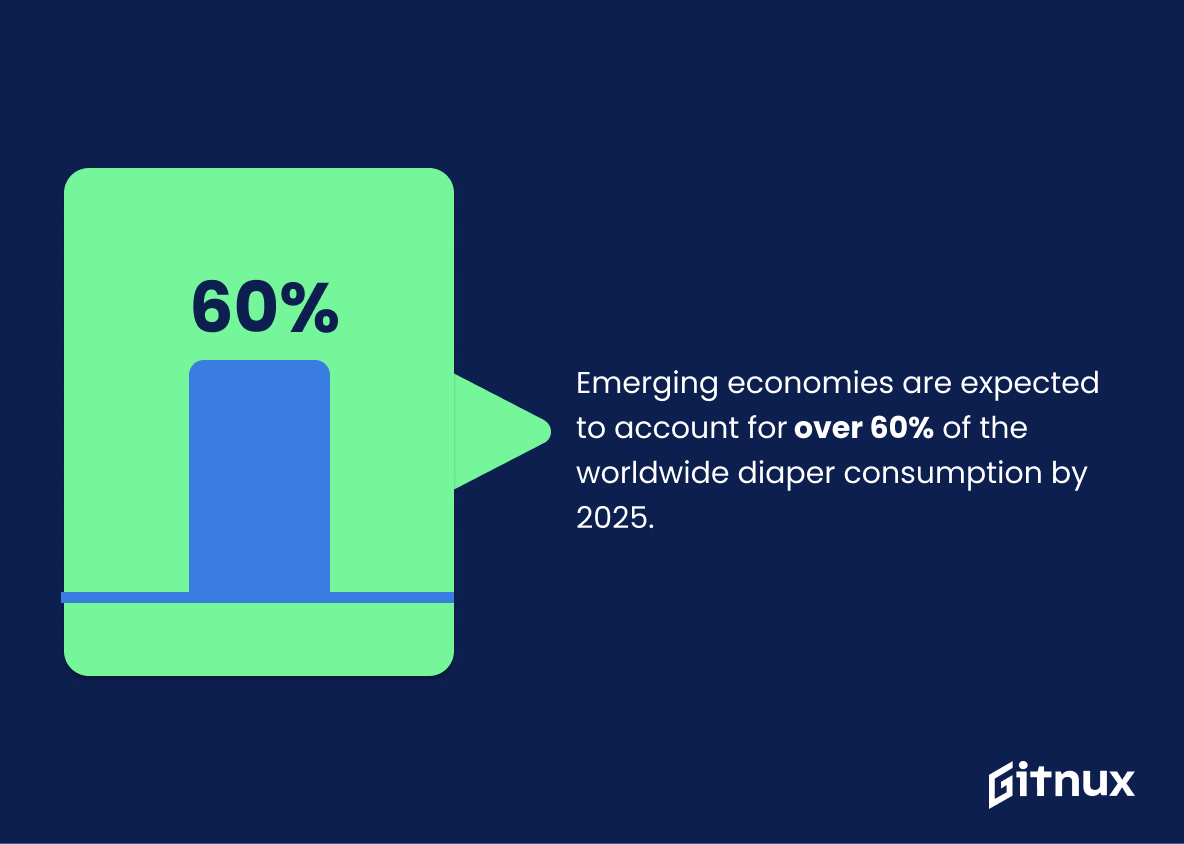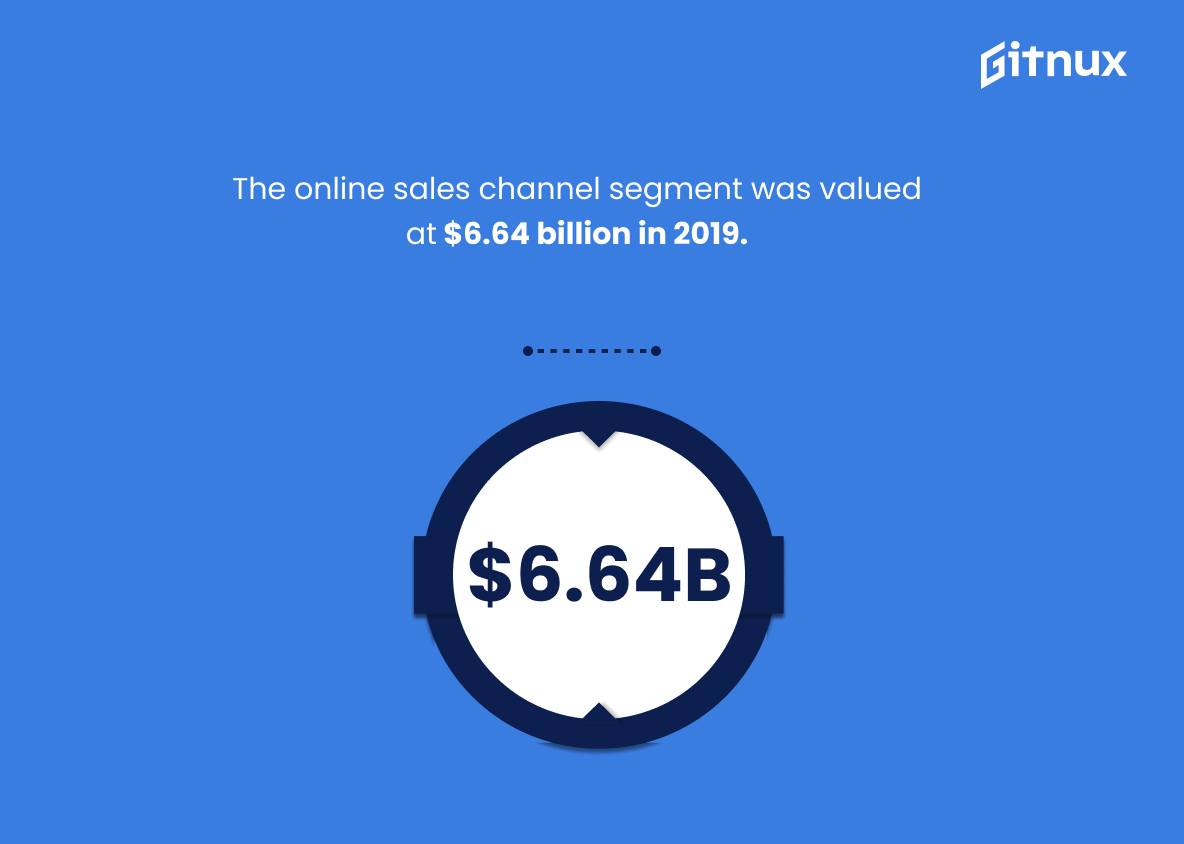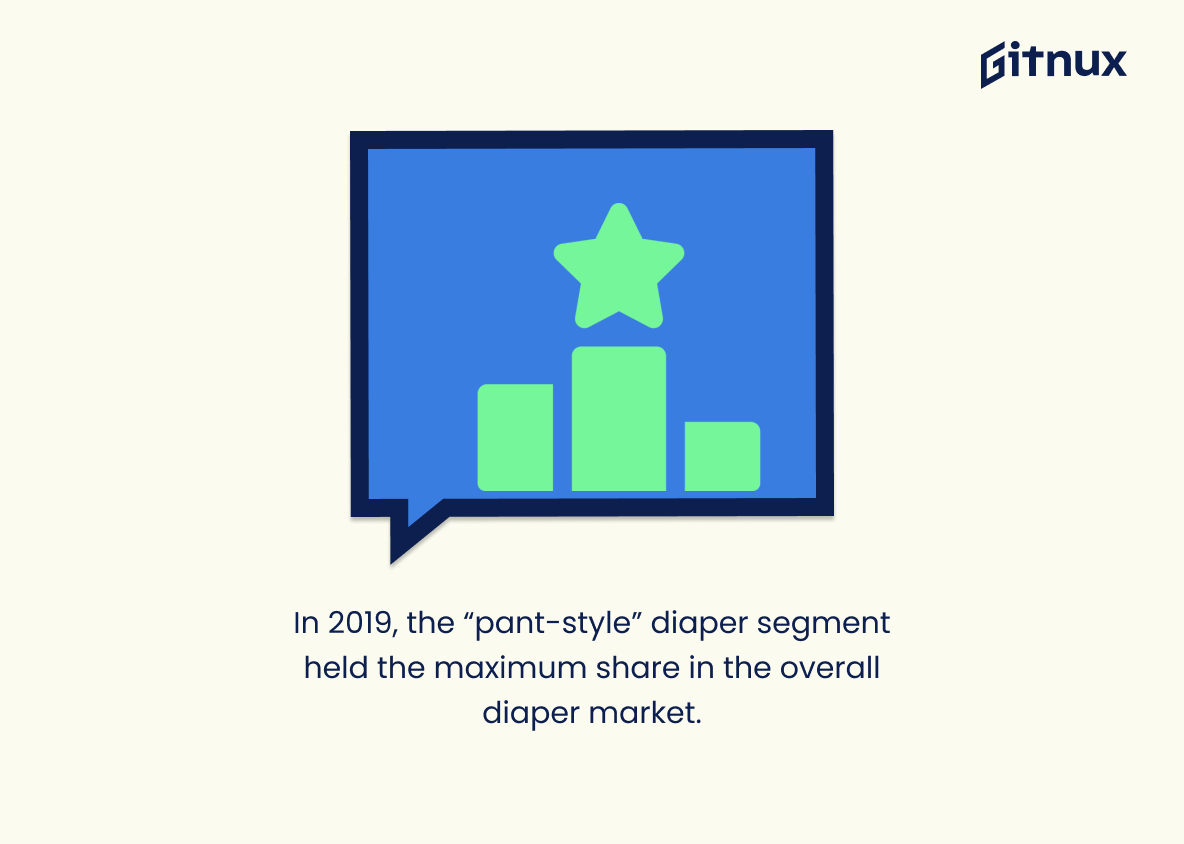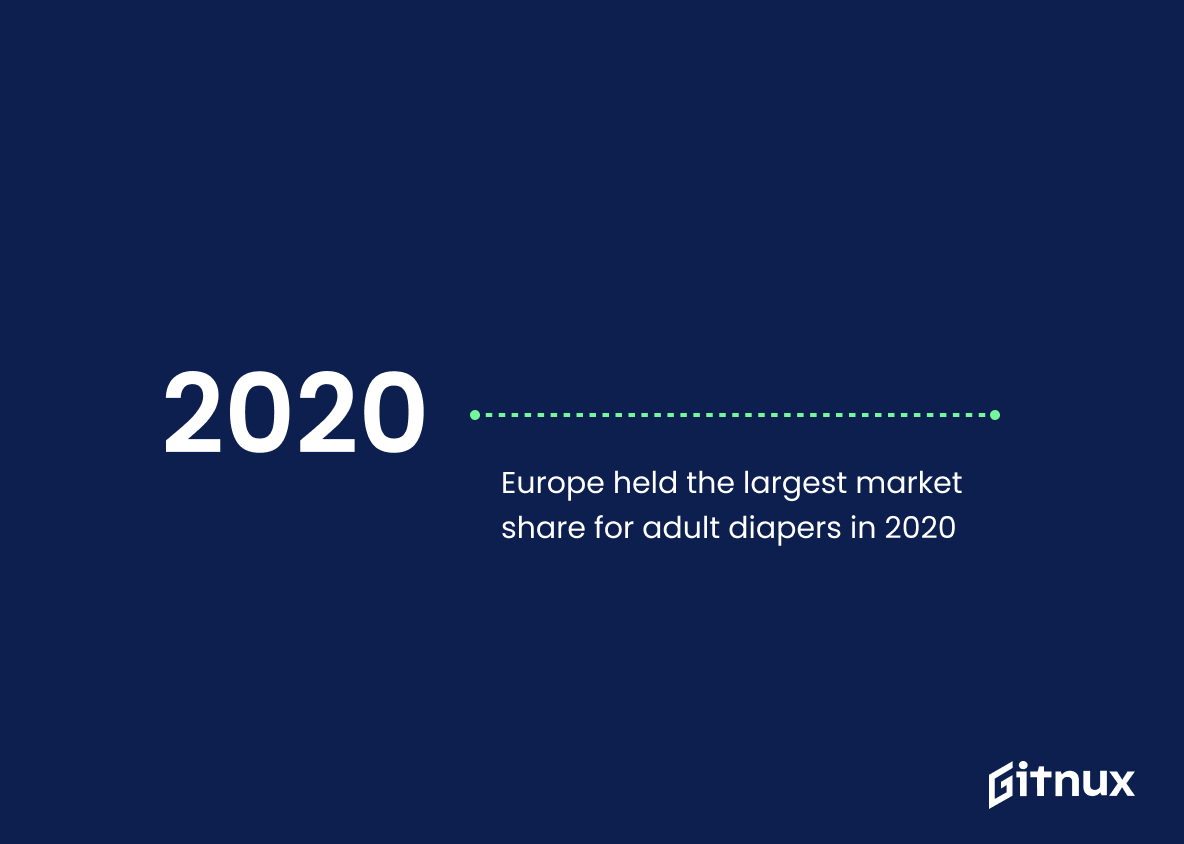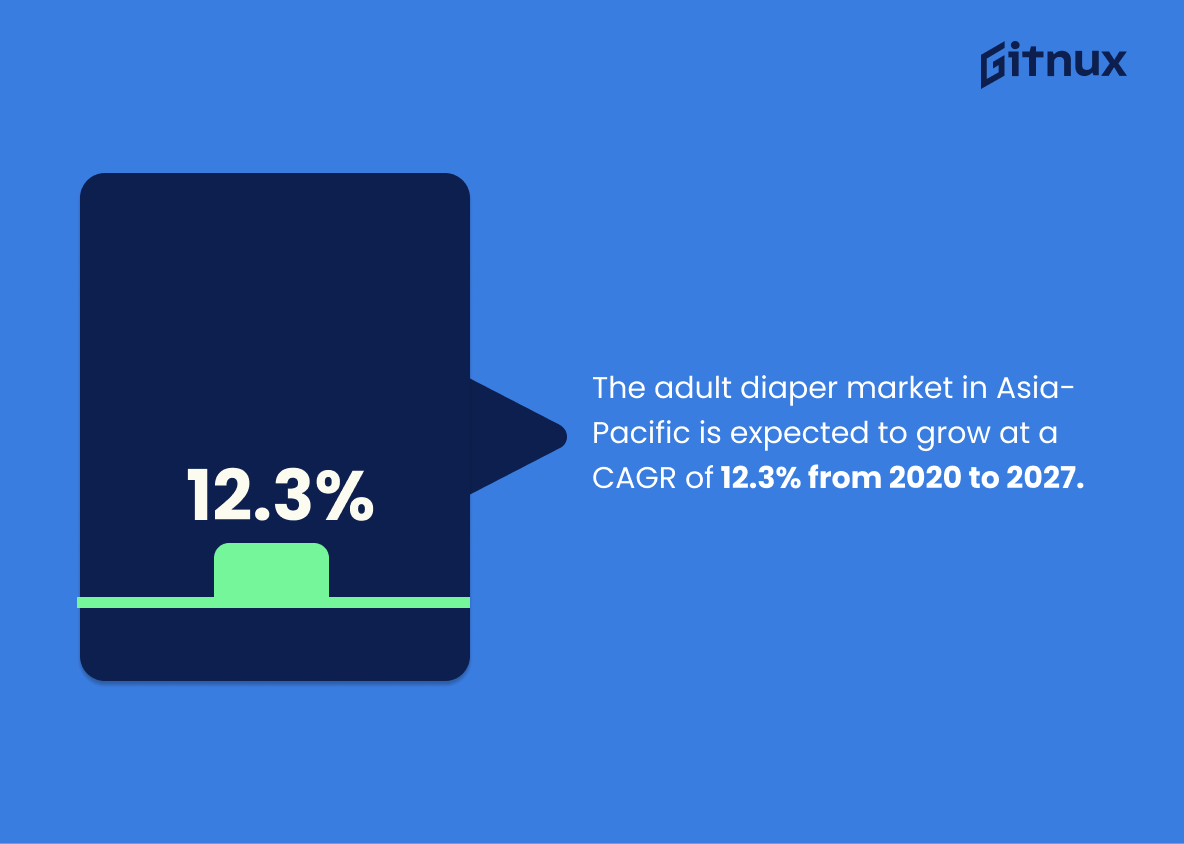The diaper industry is an undeniably crucial segment of the baby products market worldwide, impacting the lives of millions of families on a daily basis. But what lies beneath the surface of this ubiquitous product? Today’s blog post delves deep into the global diaper industry, unmasking fascinating statistics and trends.
We’ll unpack the numbers that paint a comprehensive picture of the industry dynamics, from production volumes to market shares, consumer behavior, and ecological impact. Strap in for an enlightening exploration of facts and figures that will undeniably transform your perspective of the humble diaper.
The Latest Diaper Industry Statistics Unveiled
The global baby diaper market size was valued at $52.6 billion in 2019.
In the grand tapestry of the diaper industry, the $52.6 billion valuation of the global baby diaper market in 2019 adds an incredibly vibrant color. As the beacon revealing the market’s substantial economic footprint, it underscores the deep-pocketed potential for businesses dwelling in this sector.
This figure tells a story of the vast number of parents investing in diapers, inevitably highlighting the market’s widespread reach and the ongoing demand for this essential baby product. This serves as a wake up call for entrepreneurs looking to tap into consumer markets boasting consistent growth and unrivaled reliability. It’s not just a number; it’s an impressive testament to the diaper industry’s influence globally.
The diaper market is projected to reach $64.62 billion by 2022.
Just imagine navigating the titanic diaper market steadily growing to a whopping value of $64.62 billion by 2022. The inclusion of this fact within the blog post is intriguing as it gives a glimpse into the immense potential the diaper industry holds. This staggering figure invites both current and potential investors to fully fathom the impressive growth expected in the sector.
Furthermore, it provides manufacturers with a persuasive reason to innovate, improve quality, and ramp up production, as the market is promising. For a consumer, it signals continuous availability and perhaps advancement in diaper technology. Hence, this number is like a lighthouse, guiding the course of multiple stakeholders in their diaper market related decisions.
Revenue in the Baby Diapers segment is projected to reach $5,415.9m in 2021 in the United States.
Highlighting the forecasted revenue of $5,415.9m in the Baby Diapers segment for the United States in 2021 serves as a compelling testament to the thriving landscape of the diaper industry. It underscores the tremendous growth potential and increased market demand, illustrating a lucid picture of this sector’s economic contribution.
By assessing this projected figure, businesses, investors, and market watchers can formulate strategic decisions and navigate market trends with informed precision. It’s a monetary reflection of the industry’s vitality, where product innovation and consumer needs intersect, shaping a robust market scenario.
The average baby uses 2,700 diapers in its first year.
Painting a picture of the towering diaper demand, this data nugget unveils that each newborn contributes to the use of a staggering 2,700 diapers within their first year. This striking figure takes center stage when exploring the sheer magnitude of the diaper industry, unmasking the continuous and immense requirement for these essential items by the population’s youngest members. A closer look at this figure helps us appreciate the dynamic, ever-growing market that positions the diaper industry as a critical player in the global economy.
The global adult diaper market was worth $15.3 billion in 2020.
Highlighting the valuation of the global adult diaper market at $15.3 billion in 2020 provides a lucid snapshot of the industry’s impressive financial magnitude. This staggering figure not only underscores the vast consumer demand but also illuminates the competitive economic landscape within the market.
More so, it offers a glimpse into potential untapped opportunities for businesses seeking to invest in or expand within the adult diaper arena. In the context of a blog post about Diaper Industry Statistics, such a value metric brings forth the prosperous financial standing, substantial growth, and huge market potential in this burgeoning sector.
China is currently the largest market for diapers, with a volume share exceeding 24%.
Highlighting China’s preeminence in the diaper industry, owning over 24% of the market, paints a vivid picture of the global diaper scene. Consider this: If the world of diaper consumption was an ocean, then this figure represents China as the biggest fish. It reveals the significant role China plays, making it a focal point for manufacturers and businesses intending to navigate this industry.
In broader strokes, this statistic gives palpable substance to the importance of understanding regional dynamics and consumption patterns in crafting effective market strategies, and, ultimately, staying afloat in the diaper industry.
The reusable diapers market segment is projected to register a CAGR of 7.9% during the forecast period of 2020-2027.
In an article delving into the diaper industry statistics, zooming into the reusable diapers market segment gives us entrancing insights. Picture a projected CAGR of 7.9% stretching from 2020 to 2027. This is not merely a number but showcases the burgeoning growth pace of this ecological-friendly segment.
The shifting trend towards sustainable consumer choices and environmentally less harmful products propels this niche, which could potentially reshape the future landscape of the diaper industry. This valuable piece of data serves as a precursor to the potential seismic shift, providing a compelling narrative for both consumers and businesses about the importance of navigating the trend and adapting to the evolving market.
The revenue of the baby diapers market for the biodegradable segment was over $1.3 billion in 2019.
In the great tapestry of Diaper Industry Statistics, the thread of ‘The revenue of the baby diapers market for the biodegradable segment being over $1.3 billion in 2019’ cannot be ignored. It adds depth, color, and clarity, casting light on not just the significant market value of biodegradable baby diapers but also the rising consumer consciousness towards eco-friendly products.
This fine detail delicately intertwines with other industry data, revealing a snapshot of markets responding to the eco trend and illuminating potential avenues for growth and innovation. It is, indeed, a vibrant strand helping us map the vast, intricate landscape of the diaper industry.
Emerging economies are expected to account for over 60% of the worldwide diaper consumption by 2025.
From the perspective of diaper industry statistics, the prediction of emerging economies accounting for over 60% of the global diaper consumption by 2025 illuminates two critical trends. Firstly, it underscores a shift in economic powerhouses, pushing industry players to recalibrate their focus towards these rising markets.
Secondly, it hints at increased prosperity leading to rising birth rates and improving living standards, consequently driving the demand for diapers. Such insightful data prompts diaper companies to both strategize on product innovation tailored for these newfound market needs and relocate their production facilities, thereby ensuring a sustained growth trajectory.
The online sales channel segment was valued at $6.64 billion in 2019.
In unraveling the intricate fabric of the Diaper Industry, it’s rather enlightening to stumble upon the mark $6.64 billion—alluding to the towering worth of the online sales channel segment in 2019. This monumental valuation underscores the undeniable transition of consumer preference towards ecommerce, fortifying the growth potential of digital platforms as major venues for diaper sales. Such momentous revelation, not only illuminates the robust trajectory of the digital marketplace, but also paints an alluring picture of how online sales could further revolutionize the diaper industry.
The cloth diaper market is expected to hit a worth of $9.62 billion by 2027.
Forecasting such a robust growth in the cloth diaper market, soaring to a colossal $9.62 billion by 2027, acts as an incredible spotlight shining on the dynamic landscape of the diaper industry. Not only does it underscore the escalating consumer preference for sustainability and eco-friendliness, but it also implies a future where all sectors are compelled to pivot their operations towards environmental responsibility.
Therefore, amidst a sea of diaper industry statistics, this striking projection invariably stands out, proffering a subtle foretelling of the paradigm shift that the industry is headed towards. This intriguing storyline woven by the numbers serves as a tantalizing teaser of the promising future that awaits the diaper industry.
In 2019, the “pant-style” diaper segment held the maximum share in the overall diaper market.
Painting a vivid picture of the diaper industry landscape, the statistic revealing that in 2019, the “pant-style” diaper segment dominated the overall diaper market acts as a beacon showing the prevailing trends. It pinpoints the heartbeat of consumer preferences, guiding manufacturers and stakeholders towards focusing on this particular product design.
It’s like a compass, crafting a roadmap for potential innovations and marketing strategies, while helping investors understand where the money is flowing within the diaper industry. Essentially, this statistic is the fabric narrating the compelling story of diaper fashion in 2019, weaving it into the broader tapestry of diaper industry statistics.
Europe held the largest market share for adult diapers in 2020.
Highlighting that Europe dominated the adult diapers market share in 2020 showcases the vitality of this region in the global diaper industry. Not only does it emphasize the significant purchasing power and consumer demand within Europe, but it also underscores the region’s influence on the manufacturing trends and the market strategies in the diaper industry.
Furthermore, manufacturers, investors, and new entrants into this field can leverage this information to target their efforts for maximum profitability, market penetration, and growth. The trends influencing Europe’s leading position could also be enlightening, revealing shifts in demographics, healthcare standards, or consumer preferences, which are invaluable for understanding current forecasts and future growth potential within the diaper market.
The adult diaper market in Asia-Pacific is expected to grow at a CAGR of 12.3% from 2020 to 2027.
With the anticipated surge in the Asia-Pacific adult diaper market at a CAGR of 12.3% from 2020 to 2027, we open up a discussion that touches upon an intriguing juncture in the diaper industry landscape. This data point unveils a tale of significant market evolution, one that challenges the prevailing notion of diapers being limited to infant use.
A burgeoning adult demographic is staking its claim, thereby broadening the traditional customer base and introducing a compelling episode in the story of diaper industry statistics. The acceleration of growth signals not just sizeable revenue prospects, but a shifting market focus that may engender innovative product development and marketing strategies in years to come.
The use of bio-based materials for the production of diapers is growing at a CAGR of 16.83%.
Delving into the world of diaper manufacturing trends, we’ve tapped into an exciting growth trajectory. The notable upswing of 16.83% CAGR in bio-based materials usage in diaper production can be likened to the sunrise of a more sustainable era in this industry. This statistic serves not only as a beacon of eco-conscious progress but also reveals a potential goldmine for manufacturers aligning to green practices.
It also signifies the evolving level of consumer consciousness, signposting a marked shift in buying behaviours and preferences – a point of paramount importance for market players wanting to stay ahead in the game. Astoundingly, it provides a clear-cut pathway challenging the traditional norms and directing the diaper industry towards sustainability, growth, and profits.
Total unit of baby diapers sales in the U.S. was about 36.58 million for the 52 weeks ended March 21, 2021.
Shedding light on the sheer magnitude of the diaper industry in the U.S., it’s fascinating to consider that approximately 36.58 million units of baby diapers were sold within the span of 52 weeks, wrapping up on March 21, 2021. This figure showcases the vast scale and financial potential of the industry, underlying its significant role within the U.S. economy.
It also further underscores the potential impact any shifts in production, consumption patterns, or market dynamics could have on businesses, consumers, and even environmental sustainability considerations. This powerful data point thus sets a compelling, solid stage for an in-depth exploration of the multilayered dynamics in the diaper industry.
The Asia Pacific was the largest market for baby diapers and held 40.7% of the market in 2018.
Reflecting on the captivating landscape of the diaper industry, one can’t help but observe how the Asia Pacific region emerged as the titan in 2018, cradling a staggering 40.7% of the global baby diaper market in its arms. This noteworthy number not only places a golden crown on the Asia Pacific’s head, but it also sets the tempo of the global diaper narrative which can shape the strategies of aspiring entrants and existing market players.
In tandem with the region’s booming population, this stat hints at the potential growth areas for manufacturers, the urgency of catering to diverse consumer preferences, and the race for innovations that this region can inspire for a comfortable future for our little ones.
Super-absorbent polymers (SAPs) accounted for 24% of diaper production costs in 2018.
Diving into the financial realm of the diaper industry, one cannot help but notice the significant role that Super-absorbent polymers (SAPs) play in the financial spectrum. In 2018, they dominated the scene, posing a notable 24% of the total diaper production costs. This striking figure not only tells us about the importance of SAPs in this industry, but it also sheds light on cost structures, allowing companies and investors to understand where most funds are allocated in the production process. Thus, this statistic provides a clear financial roadmap, and understanding it can yield valuable insights for those analyzing the industry’s financial health and growth potential.
P&G (Proctor and Gamble) held over 18% of the global diaper market share in 2020.
Delving into the realm of diapers, a striking number emerges from the stack of data – in 2020, Proctor & Gamble (P&G) commanded a remarkable 18% of the global diaper market. In an industry that is heavily saturated and with a vast array of brands jostling for space and consumer attention, P&G’s significant market share underscores its strength as a global power player.
This figure is a testament to P&G’s impressive reach, robust product portfolio, strategic marketing, and the consumer loyalty they’ve woven into their business model. Implications of this extend beyond the surface and offer insights to industry stakeholders interested in the brand positioning, consumer behavior, and competitive landscape in the diaper industry.
Conclusion
In a nutshell, the diaper industry continues to burgeon with constant innovations and a steady focus on sustainability and convenience. Understanding these industry statistics brings clarity to the vast potential that this market entails. As more parents switch to high-quality, eco-friendly products, manufacturers are pushed to evolve accordingly.
Given the projected growth and dynamic consumer preferences, the diaper industry is undeniably a fascinating space for both consumers and investors. As it continues to bloom, it promises more advancement and competition, unfolding a prosperous and sustainable future landscape.
References
0. – https://www.www.businesswire.com
1. – https://www.www.pewresearch.org
2. – https://www.www.fortunebusinessinsights.com
3. – https://www.www.reportlinker.com
4. – https://www.www.zionmarketresearch.com
5. – https://www.www.statista.com
6. – https://www.www.grandviewresearch.com
7. – https://www.www.expertmarketresearch.com
8. – https://www.www.globenewswire.com
9. – https://www.www.360marketupdates.com
10. – https://www.www.alliedmarketresearch.com
11. – https://www.www.technavio.com
